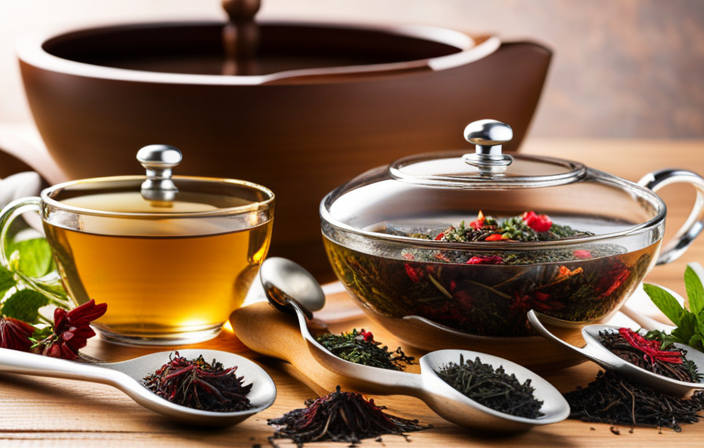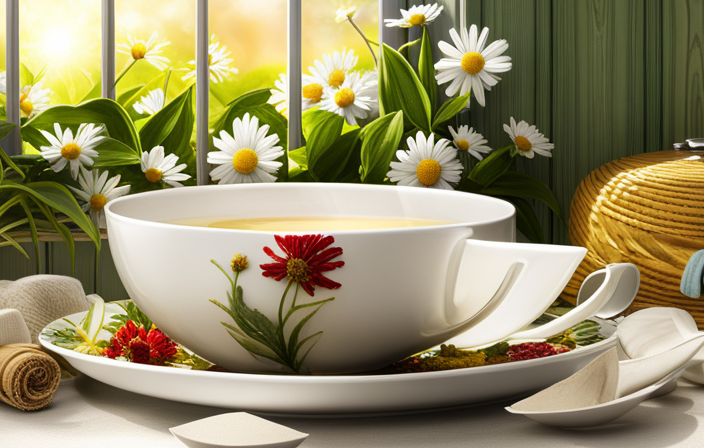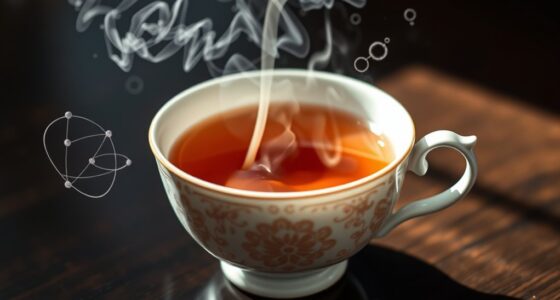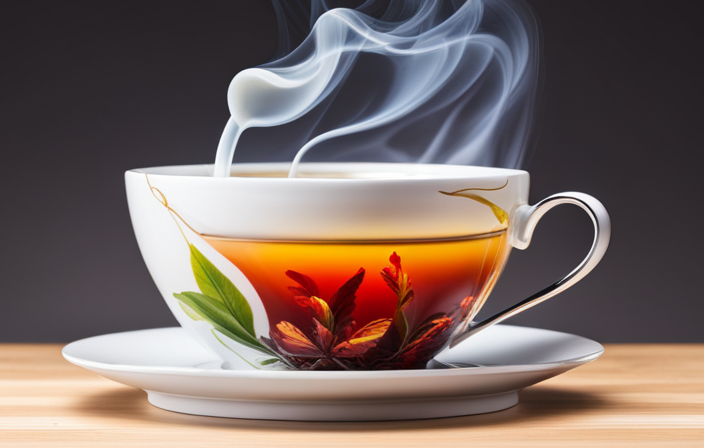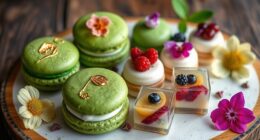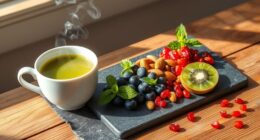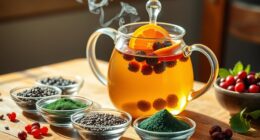I absolutely love starting my day with a warm cup of tea, but sometimes I crave a flavor that I just can’t find in the store. That’s when I discovered the joy of crafting my own tea blends.
With just a few simple steps, I can create a personalized blend that perfectly suits my taste. Whether you’re a tea enthusiast like me or just looking to try something new, I’m excited to share with you my 7 steps to crafting your own delicious tea blend.
Key Takeaways
- Choosing the right base tea is crucial for the blend, as it provides structure and body.
- Experimenting with different combinations of herbs, fruits, and spices can create a unique and harmonious flavor profile.
- Herbs and spices like turmeric, ginger, peppermint, and cinnamon can add depth and complexity to tea blends.
- Proper storage methods, such as using airtight containers and keeping away from light, heat, and moisture, are essential for maintaining the freshness and flavor of the tea blend.
Selecting the Base Tea
I need to choose the right amount of base tea for my blend. When experimenting with different teas, it’s crucial to find the perfect base that will complement the flavors you want to achieve.
The base tea sets the foundation for your blend, providing the structure and body. It’s like the canvas upon which you’ll paint your masterpiece. To choose the right base, I consider the characteristics of each tea.
For example, a black tea will provide a robust and full-bodied flavor, while a green tea will offer a lighter and more delicate taste. By understanding the unique qualities of each tea, I can create a blend that harmoniously combines flavors and satisfies the palate.
Now, let’s move on to choosing the perfect flavor profile for our tea blend.
Choosing the Perfect Flavor Profile
When crafting my own tea blend, I carefully consider the flavor profile that will best complement my chosen base tea. Choosing unique flavors is essential in creating a signature blend that stands out. I enjoy experimenting with different combinations of herbs, fruits, and spices to achieve the perfect balance of taste.
Whether it’s a hint of citrus to add brightness or a touch of floral notes for a delicate aroma, each ingredient is chosen with precision. I strive to create a blend that not only pleases my own palate but also delights those I serve. By carefully selecting the flavor profile, I ensure that every sip is a harmonious experience.
Now, let’s dive into the exciting world of exploring herbs and spices to further enhance our tea blends.
Exploring Herbs and Spices
To enhance my tea blends, I love experimenting with herbs and spices, adding depth and complexity to each sip. Exploring the health benefits and tea blending techniques of different ingredients allows me to create unique and flavorful concoctions that cater to a variety of tastes and needs.
Here are four herbs and spices that I enjoy incorporating into my blends:
-
Turmeric: Known for its anti-inflammatory properties, turmeric adds a warm and earthy flavor to teas, while also providing potential health benefits.
-
Ginger: With its spicy and invigorating taste, ginger not only adds a kick to teas but also aids in digestion and soothes the stomach.
-
Peppermint: Refreshing and cooling, peppermint adds a minty twist to teas, while also promoting digestion and relieving headaches.
-
Cinnamon: Sweet and aromatic, cinnamon lends a warm and comforting flavor to teas, while potentially boosting metabolism and regulating blood sugar levels.
By carefully selecting and combining these herbs and spices, I can create tea blends that not only taste delicious but also provide various health benefits.
Mixing and Combining Ingredients
When it comes to mixing and combining ingredients for tea blends, it’s all about finding the perfect flavor combinations.
Whether you’re opting for a traditional tea or experimenting with herbal blends, the possibilities are endless.
Don’t be afraid to play around with ingredient ratios to create your own unique and delicious concoctions.
Flavor Combinations for Tea Blends
Sometimes, I enjoy experimenting with different flavor combinations when creating my own tea blends. It’s exciting to discover unique flavors that not only taste delicious but also offer various health benefits.
Here are a few flavor combinations that I’ve found to be particularly delightful:
-
Refreshing citrus twist: a blend of green tea, lemon, and a hint of mint that invigorates the senses.
-
Soothing floral fusion: a combination of chamomile, lavender, and rose petals that promotes relaxation and calmness.
-
Spicy chai delight: a mix of black tea, cinnamon, cardamom, and ginger that warms you up and aids digestion.
-
Tropical paradise: a tropical medley of hibiscus, pineapple, and coconut that transports you to a sunny beach.
These unique combinations not only offer a delightful taste but also provide various health benefits such as antioxidants, relaxation, digestion aid, and immune support.
Now, let’s explore the differences between herbal and traditional teas.
Herbal Vs. Traditional Teas
As an avid tea enthusiast, I enjoy comparing the flavors and benefits of herbal teas and traditional teas, both by mixing and combining ingredients. When it comes to herbal teas, there are numerous health benefits to consider. Herbal teas are often caffeine-free and can help with digestion, relaxation, and boosting the immune system. On the other hand, traditional teas, such as black or green tea, contain antioxidants and can provide a natural energy boost. However, they do contain caffeine, which may not be suitable for everyone. To summarize the benefits and drawbacks of herbal vs. traditional teas, I have created a table below:
| Herbal Teas | Traditional Teas |
|---|---|
| Caffeine-free | Contains antioxidants |
| Promotes digestion and relaxation | Provides natural energy |
| Boosts immune system | May not be suitable for everyone |
Experimenting With Ingredient Ratios
I love exploring different flavor profiles by mixing and combining ingredients in my tea blends. It’s a wonderful way to create unique and personalized beverages that cater to my taste preferences. When experimenting with ingredient ratios, I find that the possibilities are endless. Here are a few techniques I enjoy exploring:
-
Layering flavors: By carefully layering different ingredients, I can create a tea blend with complex and harmonious flavor notes.
-
Balance of sweetness and bitterness: Adjusting the ratio of sweet and bitter ingredients allows me to create a well-balanced cup of tea.
-
Enhancing aroma: Adding herbs and spices with strong aromas can elevate the sensory experience of the tea.
-
Incorporating health benefits: By understanding the health benefits of various ingredients, I can create tea blends that promote wellness and vitality.
Exploring different brewing techniques and understanding the health benefits of the ingredients are essential in crafting a delicious and beneficial tea blend. However, it’s equally important to properly store your tea blend to maintain its freshness and flavor.
Properly Storing Your Tea Blend
When it comes to properly storing your tea blend, there are a few key points to consider.
First, the shelf life and freshness of your tea blend can be greatly affected by how it’s stored.
Second, using the best storage methods will help to maintain the flavor and aroma of your tea blend over time.
Lastly, understanding the importance of proper storage will ensure that you can enjoy a delicious cup of tea every time you brew.
Shelf Life and Freshness
I’m confident that proper storage techniques will extend the shelf life and freshness of my tea blend. Here are some steps I follow to ensure that my tea stays fresh for as long as possible:
-
Use airtight containers: I store my tea in containers that have airtight seals, such as glass jars or tins. This helps to prevent air, moisture, and odors from seeping in and affecting the flavor and freshness of the tea.
-
Keep away from light: Light can degrade the quality of tea over time, so I store my tea in a dark and cool place, such as a pantry or cupboard. This helps to preserve the natural flavors and aromas of the tea.
-
Avoid temperature fluctuations: Extreme temperatures can affect the shelf life of tea, so I make sure to store my tea in a place where the temperature remains consistent. This helps to prevent the tea from deteriorating prematurely.
-
Rotate stock: To ensure that I’m always using the freshest tea, I rotate my stock regularly. This means using older tea first and replenishing my supply with fresh batches. By doing this, I can enjoy the best flavors and aromas that my tea blend has to offer.
Best Storage Methods
To maintain the freshness and quality of your tea blend, it’s essential to utilize airtight containers and store them in a dark, cool place. Different types of tea containers can be used, such as glass jars with rubber seals or metal tins with tight-fitting lids. These containers help to prevent air, light, and moisture from compromising the flavor and aroma of your tea.
When storing your tea, it’s important to keep it away from strong odors, as tea can easily absorb them. A pantry or cupboard is an ideal location, as it provides a consistent temperature and protects the tea from direct sunlight.
By following these storage methods, you can ensure that your tea stays fresh and flavorful for longer periods.
Now that we’ve discussed the best storage methods, let’s move on to brewing and enjoying your homemade tea.
Brewing and Enjoying Your Homemade Tea
I have just brewed my third cup of homemade tea, and it tastes absolutely delightful. The aroma fills the room, creating a cozy atmosphere as I savor each sip.
Brewing your own tea allows for a personalized experience, and it’s surprisingly simple. Here are a few brewing techniques to help you get started:
-
Choose your tea: From black to green, herbal to oolong, the options are endless. Find a tea that suits your taste and desired health benefits.
-
Water temperature: Different teas require different water temperatures for optimal flavor extraction. Pay attention to the recommended temperature on the packaging.
-
Steep time: Steeping time also varies depending on the type of tea. Follow the instructions to ensure a perfect brew.
-
Experiment with additives: Enhance your homemade tea by adding honey, lemon, or fresh herbs for an extra burst of flavor.
Brewing your own tea not only allows you to tailor the taste to your liking but also offers numerous health benefits. From boosting your immune system to aiding digestion, homemade tea is a wonderful addition to a healthy lifestyle.
Experimenting and Refining Your Recipe
After trying out various combinations, I found that adding a pinch of cinnamon to my tea recipe enhances the flavor perfectly. Experimenting with different techniques and conducting taste tests has allowed me to refine my recipe and create a truly unique and delicious blend.
The addition of cinnamon adds a warm and comforting note to the tea, balancing out the other flavors and creating a harmonious taste experience. The key to successful experimentation is to start with a solid base and gradually introduce new ingredients, noting the changes in taste and aroma with each addition.
Taste testing is essential in determining the right balance of flavors and ensuring that the final product is satisfying to the palate. Through this process, I’ve discovered that a simple pinch of cinnamon can elevate my tea to a whole new level of enjoyment.
Frequently Asked Questions
How Long Does It Take to Create a Unique Tea Blend From Scratch?
Creating a unique tea blend from scratch can take anywhere from a few hours to several days, depending on various factors. Factors affecting the time include the complexity of flavors desired, the availability of ingredients, and the experimentation process.
To speed up the process, it’s helpful to have a clear vision of the flavor profile you want and to experiment with different tea bases to find the perfect combination.
With practice and experience, you’ll be able to craft your own tea blend efficiently and deliciously.
Can I Use Any Type of Tea as a Base for My Blend?
Yes, you can use any type of tea as a base for your tea blend. The types of tea suitable for blending are vast, ranging from black and green teas to herbal and fruit infusions.
Each type of tea brings its own unique flavor profile and health benefits to the blend. By using different tea bases, you can create a harmonious blend that combines the best qualities of each tea, resulting in a truly delightful and beneficial beverage.
Are There Any Specific Herbs or Spices That Should Be Avoided When Creating a Tea Blend?
When creating a tea blend, it’s important to be mindful of certain herbs or spices that should be avoided. Some ingredients, like licorice root or valerian, can have strong flavors that overpower the other elements in the blend. It’s best to use these sparingly or omit them altogether.
Additionally, be cautious with potent herbs like lavender or mint, as they can dominate the taste. Balancing flavors in a tea blend requires experimentation and careful consideration of each ingredient’s impact.
Is It Possible to Create a Tea Blend That Offers Health Benefits?
Creating tea blends for specific health benefits isn’t only possible, but also a reality backed by scientific research.
Exploring the science behind health claims of tea blends reveals the powerful compounds present in various herbs and spices that can promote wellness.
By carefully selecting and combining ingredients like chamomile for relaxation or ginger for digestion, you can craft a tea blend that offers targeted health benefits.
It’s an exciting journey to discover the potential of tea in serving others’ well-being.
Can I Sell My Homemade Tea Blend Commercially?
Yes, you can sell your homemade tea blend commercially, but there are legal regulations you need to be aware of. Selling food products, including tea blends, typically requires compliance with health and safety standards, labeling requirements, and obtaining necessary permits and licenses.
It’s important to research and understand these regulations to ensure you’re operating within the law. Additionally, consider consulting with a legal professional or relevant authorities to ensure that you’re meeting all the necessary requirements.
Conclusion
Crafting your own tea blend is a delightful and rewarding experience. By following these 7 simple steps, you can create a personalized tea that tantalizes your taste buds and soothes your soul.
- Selecting the right base tea
- Experimenting with flavor profiles
- Exploring a variety of herbs and spices
These steps will lead you to a perfect blend.
With proper storage and brewing techniques, you can indulge in a cup of homemade tea that’s both satisfying and invigorating.
So unleash your creativity and start blending your way to tea bliss!

